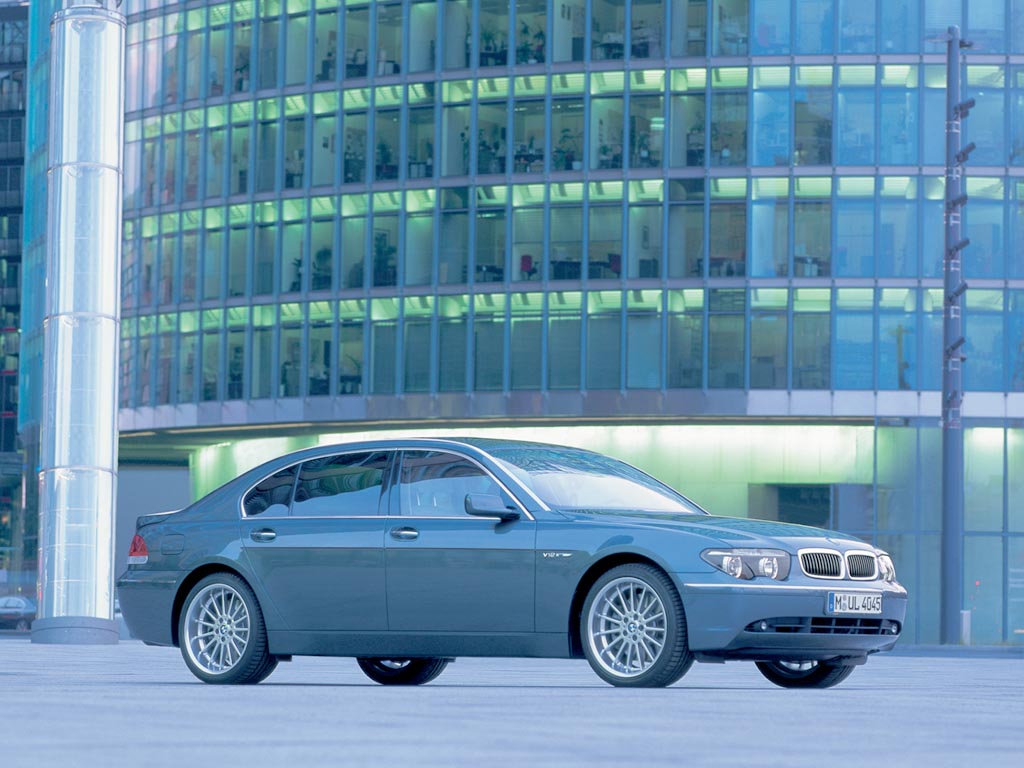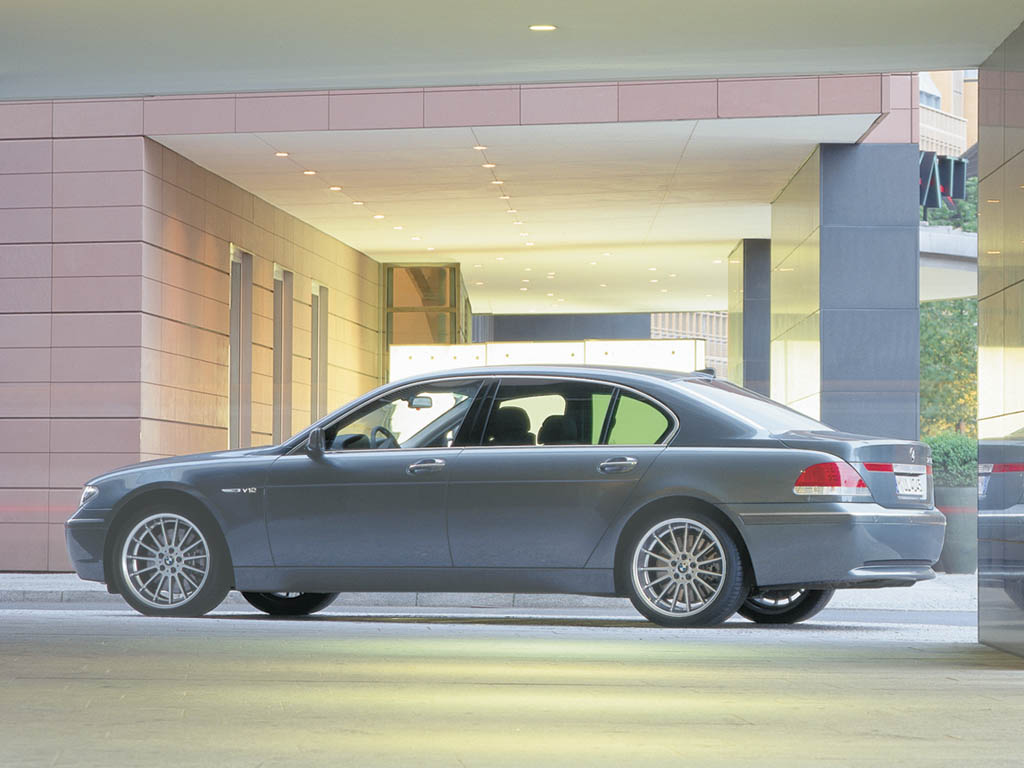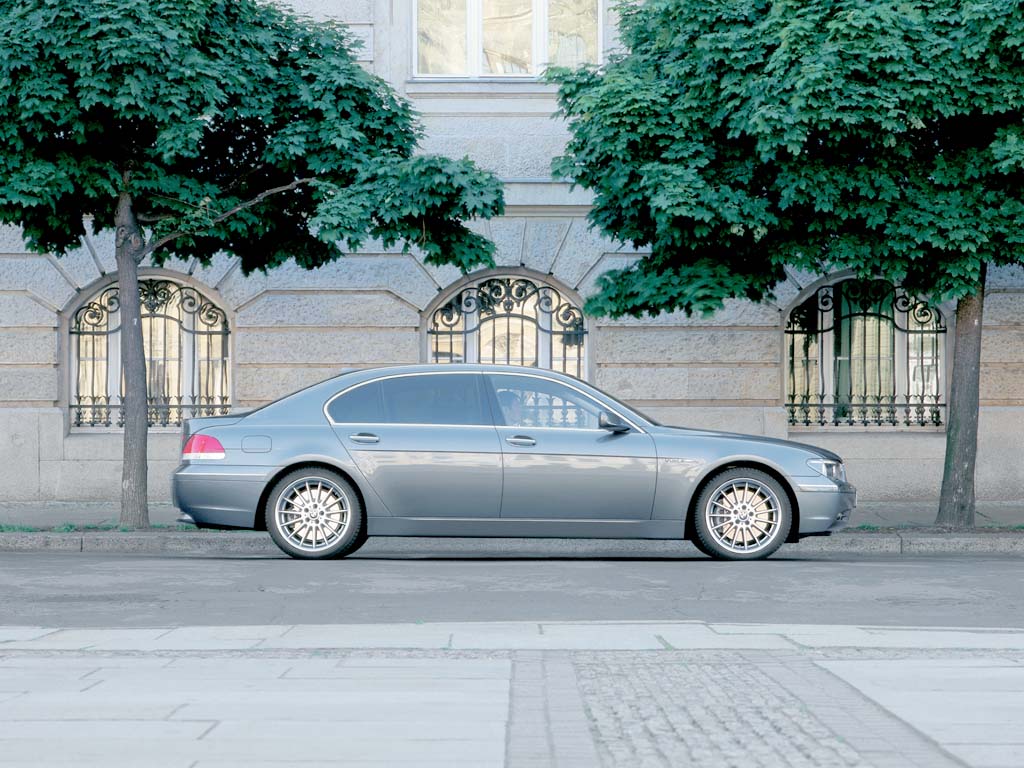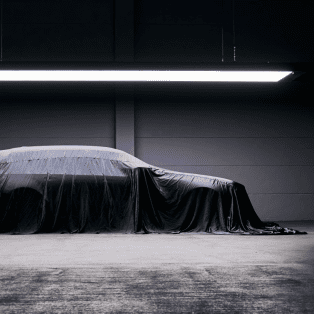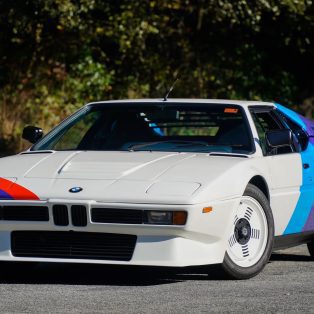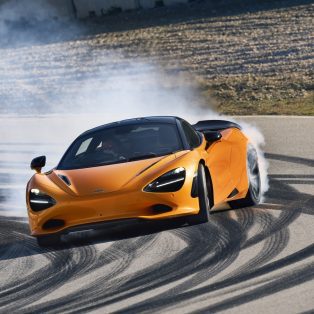2002 BMW 760i
The exclusive 12-cylinder models can be distinguished from outside by the discreet V12 logo on the car’s flanks behind the front wheel arches, the wider BMW kidney grille with chrome slats as well as, the B-pillars, the exterior mirror base, and the rear window quarterlight trim. In addition, the bumpers feature chrome inserts and the 760Li comes with chrome trim along the entire roof rail from the bottom of the windscreen all the way to the lid of the luggage compartment.
Light-alloy rims in 18-inch star-spoke design and with 245/50 R18 tyres featured only on the V12 round off the wide range of exclusive details showing the observer clearly from outside that this is a very special version of the BMW 7 Series. Illuminated V12 logos incorporated in the stainless-steel cutout trims in all four doors also show the driver and his passengers that this is the most sophisticated model in the range.
Inside the car, the instrument panel finished in leather on top and featuring beautiful seams just like the leather trim on the window strips and storage boxes in the doors again bears testimony to the V12. The roof grab handles, in turn, come with wood inserts. Elaborate inlays in the genuine wood trim and sun visors as well as the roof lining finished in Alcantara, again with beautiful visible seams, round off the impression of luxurious elegance combined with modern architecture.
12-Cylinder Power Unit.
Through its concept and configuration alone, the 12-cylinder petrol engine is acknowledged by customers and engineers alike as the supreme standard in exclusivity, refinement and comfort. The myth of that coin standing upright on the engine running without the slightest sound even at maximum engine speeds is certainly applicable here. Indeed, no other engine comes as close to the very best physics can offer as the 12-cylinder in 60 degree V-arrangement. With its supreme inner balance and the complete absence of free mass and momentum forces, this kind of engine is quite simply a legend from the start. And in addition to all this, BMW’s 12-cylinder comes with Valvetronic and direct fuel injection.
Direct fuel injection in the BMW V12 comes in combination with BMW’s revolutionary Valvetronic valve control which has already proven its qualities hundreds of thousands of times. Whilst Valvetronic is responsible for outstanding fuel economy under part load, direct fuel injection serves primarily to boost torque and output to an even higher level.
Direct Injection
Introducing the new 12-cylinder power unit, BMW is presenting a direct-injection engine for the first time in the history of the Company. With this technology one high-pressure jet per cylinder injects an exactly dosed amount of fuel directly into the combustion chamber instead of the intake manifold.
BMW thus uses direct fuel injection to boost engine output to an even higher level. As an alternative, it would of course have been possible to achieve
the same output with a larger engine or by turbocharging, but this would have meant more weight and, as a result, less favourable axle load distribution,
at the same time requiring more space and ultimately increasing the cars fuel consumption. Direct injection is therefore a particularly intelligent solution for increasing the output and torque of an engine without making compromises and accepting other drawbacks.
Valvetronic
Valvetronic replaces the throttle butterfly by fully variable intake valve opening times controlling both the duration and degree of valve motion. The technology used for this purpose is straightforward and ingenious in one: An interim lever is fitted between the camshaft and the two intake valves on each cylinder. The position of this interim lever relative to the camshaft can be adjusted infinitely by an additional eccentric shaft operated by an electric motor. Depending on the position of the eccentric shaft, in turn, the lever converts valve lift into a larger or smaller movement of the valves, according to what is required in each case.
Yet a further point is that Valvetronic is based consistently on BMWs proven infinite camshaft control, which has been in the market since 1992. Called VANOS, this system is an integral part of the Valvetronic concept and plays an important role in achieving smooth and harmonious output and torque, keeps the engine idling smoothly and masterminds the internal reflow of exhaust emissions in order to save fuel. The BMW V12 power unit features no less than four VANOS adjusters, one for each of the four camshafts.
Six-speed automatic transmission
Like all models in the BMW 7 Series, the 760i comes with six-speed automatic transmission offering ideal conditions for smooth, refined and efficient use of the 12-cylinders ample torque and power. Compared with former five-speed automatic transmission units, this new, state-of-the-art transmission provides a much larger overall transmission ratio offering advantages particularly when setting off and at high speeds: The lowest gear ensures even more traction and pulling forces, thus improving the car’s acceleration to an even higher standard. At the other end of the overall transmission ratio the additional sixth gear reduces engine speeds and, accordingly, both fuel consumption and noise.
Featuring shift-by-wire technology, the automatic transmission, like on all 7 Series, can be controlled in all its functions straight from the steering wheel. The absence of any kind of mechanical link between the transmission selector lever and the transmission itself means extra comfort for the driver. The passengers, in turn, benefit from the absence of acoustic and vibration bridges otherwise resulting from the mechanical connection between the selector lever and the transmission, noise and vibration comfort therefore being enhanced to an even higher level than before.
Suspension: Electronic Dampers
Dynamic Drive is a particular highlight in BMW’s advanced suspension technology, applying counter-forces on the front and rear anti-roll bars to effectively suppress any side roll of the body. Unlike other systems in the market, Dynamic Drive ensures optimum efficiency without any negative effect of spring travel or damper characteristics. The result is a standard of agility in bends otherwise only provided by a genuine sports saloon combined with positive comfort and outstanding ride qualities particularly for the passengers at the rear.
Serving as the second suspension control system, Electronic Damper Control (EDC-C) adds to these qualities by continuously and infinitely adjusting the dampers both front and rear according to a very clear and straightforward philosophy: ‘As much comfort as possible and as much driving stability as necessary’. So regardless of whether you are driving on a country road full of pitholes or on an ondulating motorway, EDC-C solves the old conflict of interests which previously always meant a compromise and the need to cut corners. The sports-minded driver, incidentally, has the option to choose a firmer setting of the dampers for even more dynamic motoring.
Braking and Traction Control
The BMW 760i/760Li is equipped with high-performance brakes. With their double-piston aluminium swing-calliper configuration and brake discs measuring 370 mm or 14.6 inches on all four wheels, these brakes would look good even on a thoroughbred sports car. They guarantee very short stopping distances and a good feeling on the brake pedal giving the driver confidence even in very bad weather and extreme temperatures.
Since BMW regards the driving stability system (DSC or BMW Dynamic Stability Control), according to the Company’s philosophy, as assistance for the driver, but not for a suspension possibly requiring such support to conceal any weak points, DSC can be fully deactivated at the touch of a button.
There is also an additional mode enabling the dynamic driver to override the reduction in engine power whenever the car should oversteer, while maintaining the stabilising brake effect in the interest of maximum performance on the road. Traction control (ASC or BMW Automatic Stability Control) preventing possible wheel slip when setting off is included in this driving stability system, as is the electronic differential lock (ADB or BMW Automatic Differential Brake).
In Detail
| type | Series Production Car |
| built at | Munich, Germany |
| engine | Direct Injection V12 |
| position | Front Longitudinal |
| valvetrain | 4 Valves per Cyl w/Valvetronic |
| fuel feed | Direct Injection |
| displacement | 6000 cc / 366.1 in³ |
| bore | 89 mm / 3.5 in |
| stroke | 80 mm / 3.15 in |
| power | 331.8 kw / 445 bhp @ 6000 rpm |
| specific output | 74.17 bhp per litre |
| bhp/weight | 205.54 bhp per tonne |
| torque | 600 nm / 442.5 ft lbs @ 3950 rpm |
| driven wheels | RWD w/Dynamic Stability Control (DSC), Electronic Differential L |
| front tires | 245/50R18 100W |
| rear tires | 245/50R18 100W |
| front brakes | Inner Vented Discs w/Twin-Piston Calipers, Electronic Brake Force Distribution (EBV + CBC), Emergency Brake Function (DBC) |
| rear brakes | Inner Vented Discs w/Twin-Piston Calipers, Electronic Brake Force Distribution (EBV + CBC), Emergency Brake Function (DBC) |
| front wheels | F 45.7 x 20.3 cm / 18 x 8 in |
| rear wheels | R 45.7 x 20.3 cm / 18 x 8 in |
| steering | Rack & Pinion w/Power Assist |
| f suspension | Double-Joint Thrust-Rod Spring Strut Axle w/Electronic Damper Control (EDC-C) |
| r suspension | Multi-Link Axle w/Electronic Damper Control (EDC-C) |
| curb weight | 2165 kg / 4773 lbs |
| wheelbase | 2990 mm / 117.7 in |
| front track | 1578 mm / 62.1 in |
| rear track | 1582 mm / 62.3 in |
| length | 5092 mm / 200.5 in |
| width | 1902 mm / 74.9 in |
| height | 1492 mm / 58.7 in |
| transmission | ZF 6HP26 6-Speed Auto w/Steptronic function |
| gear ratios | 4.17:1, 2.34:1, 1.52:1, 1.14:1, 0.87:1, 0.69:1 |
| final drive | 3.15:1 |
| top speed | ~250 kph / 155.3 mph |
| 0 – 60 mph | ~5.4 seconds |




